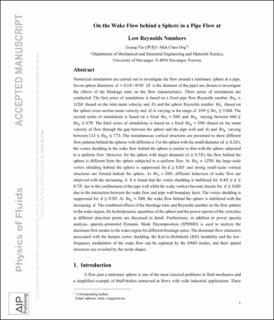| dc.contributor.author | Yin, Guang | |
| dc.contributor.author | Ong, Muk Chen | |
| dc.date.accessioned | 2020-10-15T12:35:35Z | |
| dc.date.available | 2020-10-15T12:35:35Z | |
| dc.date.created | 2020-10-08T15:53:20Z | |
| dc.date.issued | 2020-10 | |
| dc.identifier.citation | Yin, G., Ong, M.C. (2020) On the wake flow behind a sphere in a pipe flow at low Reynolds numbers. Physics of Fluids, 32(10), https://doi.org/10.1063/5.0017349 | en_US |
| dc.identifier.uri | https://hdl.handle.net/11250/2683105 | |
| dc.description | This article may be downloaded for personal use only. Any other use requires prior permission of the author and AIP Publishing. This article appeared in Physics of Fluids, 2020, 32(10) and may be found at https://doi.org/10.1063/5.0017349. | en_US |
| dc.description.abstract | Numerical simulations are carried out to investigate the flow around a stationary sphere in a pipe. Seven sphere diameters d = 0.1D–0.9D (D is the diameter of the pipe) are chosen to investigate the effects of the blockage ratio on the flow characteristics. Three series of simulations are conducted. The first series of simulations is based on a fixed pipe flow Reynolds number Rep = 1250 (based on the inlet mean velocity and D) and the sphere Reynolds number Res (based on the sphere cross-sectional mean velocity and d) that is varying in the range of 249 ≤ Res ≤ 1360. The second series of simulations is based on a fixed Res = 500 and Rep varying between 460 ≤ Rep ≤ 678. The third series of simulations is based on a fixed Reg = 500 (based on the mean velocity of flow through the gap between the sphere and the pipe wall and d) and Rep varying between 113 ≤ Rep ≤ 773. The instantaneous vortical structures are presented to show different flow patterns behind the spheres with different d. For the sphere with the small diameter (d ≤ 0.5D), the vortex shedding in the wake flow behind the sphere is similar to that with the sphere subjected to a uniform flow. However, for the sphere with a larger diameter (d ≥ 0.7D), the flow behind the sphere is different from the sphere subjected to a uniform flow. At Rep = 1250, the large-scale vortex shedding behind the sphere is suppressed for d ≥ 0.8D and strong small-scale vortical structures are formed behind the sphere. At Res = 500, different behaviors of wake flow are observed with the increasing d. It is found that the vortex shedding is stabilized for 0.4D ≤ d ≤ 0.7D due to the confinement of the pipe wall, while the wake vortices become chaotic for d ≥ 0.8D due to the interaction between the wake flow and the pipe wall boundary layer. The vortex shedding is suppressed for d ≥ 0.9D. At Reg = 500, the wake flow behind the sphere is stabilized with the increasing d. The combined effects of the blockage ratio and Reynolds number on the flow pattern in the wake region, the hydrodynamic quantities of the sphere, and the power spectra of the velocities at different detection points are discussed in detail. Furthermore, in addition to power spectral analysis, sparsity-promoted Dynamic Mode Decomposition (SPDMD) is used to analyze the dominant flow modes in the wake region for different blockage ratios. The dominant flow characters associated with the hairpin vortex shedding, the Kelvin–Helmholtz instability, and the low-frequency modulation of the wake flow can be captured by the DMD modes, and their spatial structures are revealed by the mode shapes. | en_US |
| dc.language.iso | eng | en_US |
| dc.publisher | American Institute of Physics | en_US |
| dc.title | On the wake flow behind a sphere in a pipe flow at low Reynolds numbers | en_US |
| dc.type | Peer reviewed | en_US |
| dc.type | Journal article | en_US |
| dc.description.version | acceptedVersion | en_US |
| dc.subject.nsi | VDP::Matematikk og Naturvitenskap: 400::Fysikk: 430 | en_US |
| dc.source.volume | 32 | en_US |
| dc.source.journal | Physics of Fluids | en_US |
| dc.identifier.doi | 10.1063/5.0017349 | |
| dc.identifier.cristin | 1838269 | |
| cristin.ispublished | true | |
| cristin.fulltext | postprint | |
| cristin.qualitycode | 2 | |
